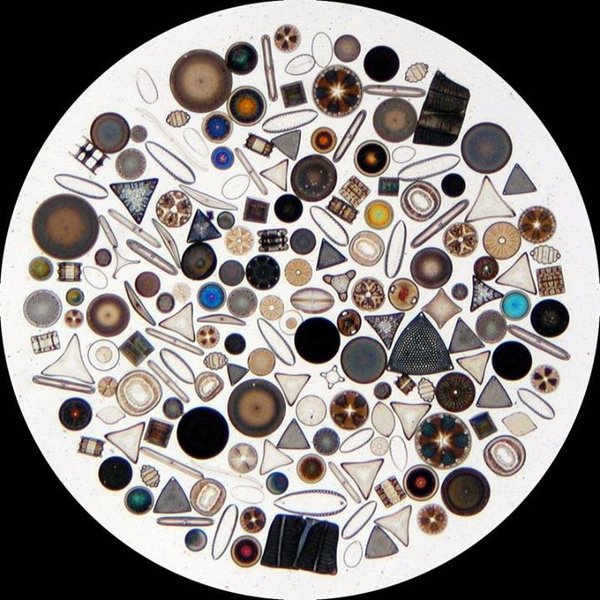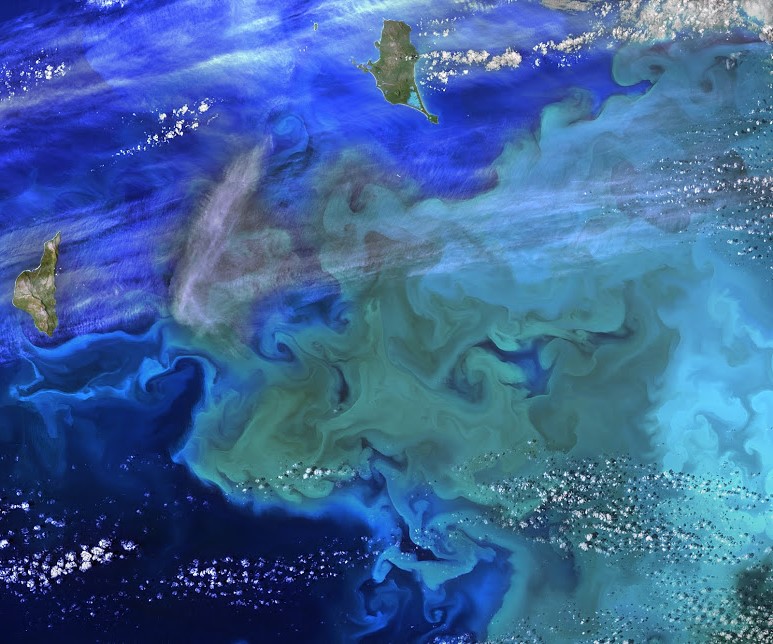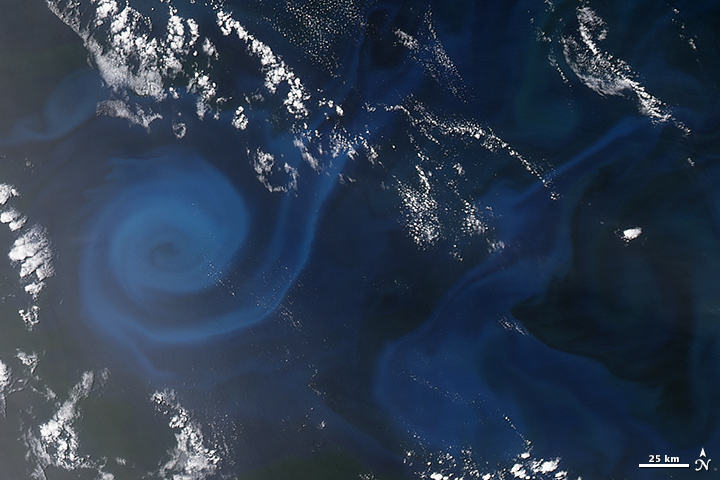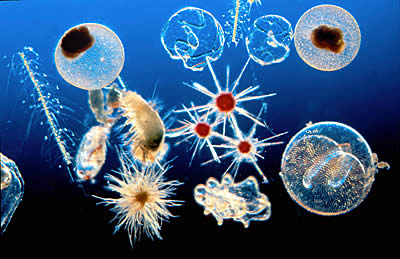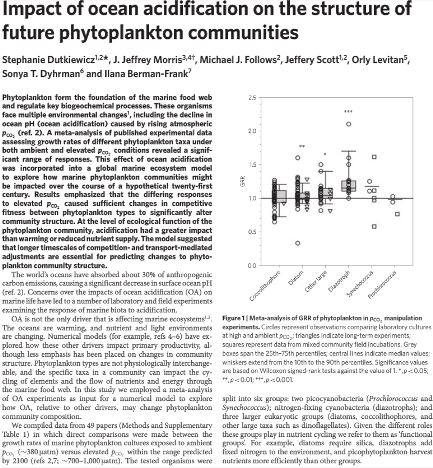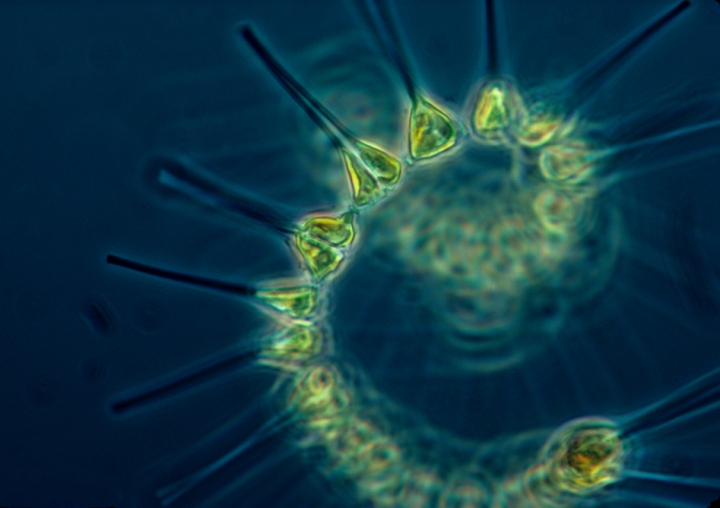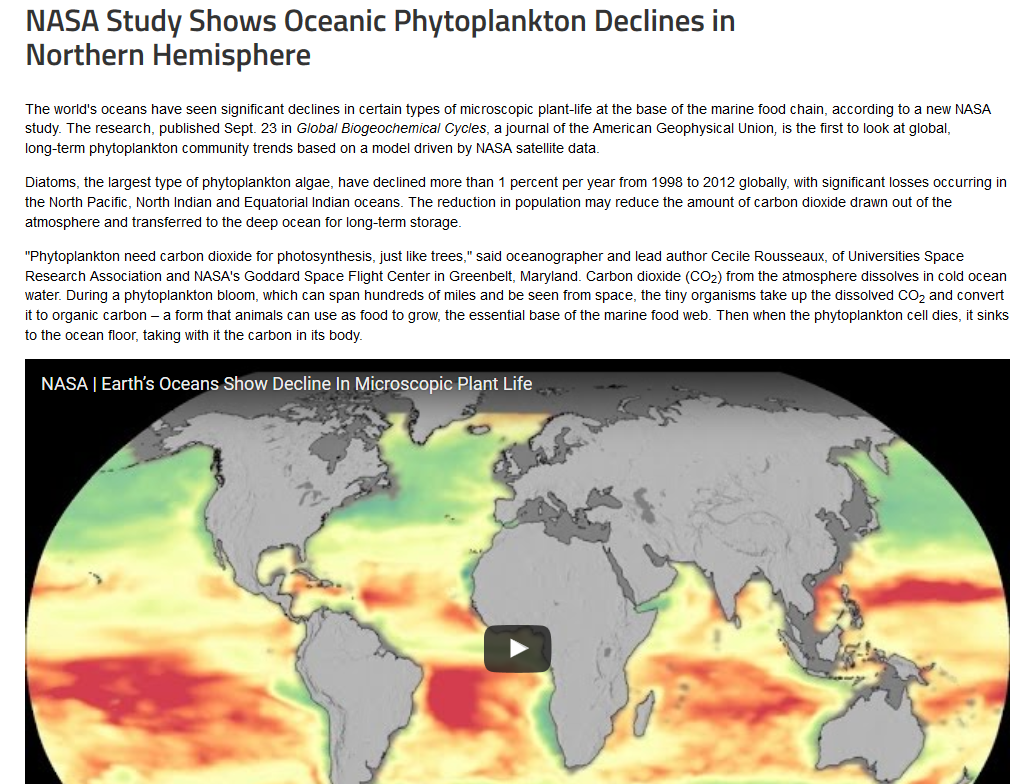File:Phytoplankton.jpg
Phytoplankton.jpg (600 × 600 pixels, file size: 97 KB, MIME type: image/jpeg)
Photosynthesis <- -> Phytoplankton
~~ Phytoplankton account for half of all photosynthetic activity on Earth ....
○ ○ ○ ○ ○ ○ ○ ○ ○ ○ ○ ○ ○ ○ ○ ○ ○ ○ ○ ○ ○ ○ ○ ○ ○ ○ ○ ○ ○ ○ ○ ○
Phytoplankton rapidly disappearing
Loss of mini marine plants at base of food web threatens sea’s ecology
A rapid loss of phytoplankton threatens to turn the western Indian Ocean into an “ecological desert,” a new study warns. The research reveals that phytoplankton populations in the region fell an alarming 30 percent over the last 16 years.
A decline in ocean mixing due to warming surface waters is to blame for that phytoplankton plummet, researchers propose online January 19 in Geophysical Research Letters. The mixing of the ocean’s layers ferries phytoplankton nutrients from the ocean’s dark depths up into the sunlit layers that the mini plants inhabit.
The loss of these microbes, which form the foundation of the ocean food web, may undermine the region’s ecosystem, warns study coauthor Raghu Murtugudde, an oceanographer at the University of Maryland in College Park.
“If you reduce the bottom of the food chain, it’s going to cascade...”
-- Via Science News, February 2016 ... https://www.sciencenews.org/article/phytoplankton-rapidly-disappearing-indian-ocean
~ ~ ~ ~ ~ ~ ~ ~ ~ ~ ~ ~ ~ ~ ~ ~ ~ ~ ~ ~ ~ ~ ~ ~ ~ ~ ~ ~ ~ ~ ~ ~ ~ ~ ~ ~
http://www.greenpolicy360.net/w/Earth_Science_Research_from_Space
~ ~ ~ ~ ~ ~ ~ ~ ~ ~ ~ ~ ~ ~ ~ ~ ~ ~ ~ ~ ~ ~ ~ ~ ~ ~ ~ ~ ~ ~ ~ ~ ~ ~ ~ ~
Phytoplankton are responsible for much of the oxygen present in the Earth’s atmosphere, half the total amount produced by all plant life
○
"Charismatic" recognizable species v the tiny "little ones": It's essential to recognize the rarely recognized species
GP360: The standard approach, when looking at threatened species, is to focus on well-known larger species. The Red List is widely known for its work to identify species at risk of extinction. Its work forms the basis for many biodiversity preservation efforts. The focus on [https://en.wikipedia.org/wiki/The_world's_100_most_threatened_species larger, readily identified animals is the norm and these species, often mammals, provides just a part of the larger picture of our threatened environment.
The large 'charismatic', or 'iconic' species, most often eclipse recognition of rarely considered species that are not even 'known' or known to be in danger... The reality is that much of the extinction in our era is of the small species, the lesser known, unknown and unconsidered species, whether in the rich biospheres of the rainforest or the oceans, the micro-organisms are at risk and in peril of collapse.
When we speak of Plankton, as a profoundly critical keystone species, the food chain of the oceans begins with plankton, yet the disruption of the atmosphere and the heating of the ocean, or acidification, will have great consequences to the Phytoplankon, flagellates who cannot move with their limited locomotion system... Acidification of the oceans and the increases of heat or strengthened suns rays due to changes in atmospheric conditions and UV radiation can have deadly consequences to the 'least of and smallest of' the species -- and as a result effect the larger systems in ways that science is only now beginning to measure and monitor.
We are, our species is, beginning to understand that as the small animals comprising the foundations of the 'food chain' and biosphere systems are disrupted, endangered and/or destroyed, the rest of the food chain and integral ecological connections between species will be disrupted, endangered, and/or destroyed. This is a great challenge of the era in which we live... loss of biodiversity and a 'ripple effect' over time, a threat environment that demands strategic environmental security as a key goal, as a policy objective beginning with awareness and policies and practices of sustainability.
○
SMALL v LARGE SPECIES
http://en.wikipedia.org/wiki/Phytoplankton
Phytoplankton obtain energy through the process of photosynthesis and must therefore live in the well-lit surface layer (termed the euphotic zone) of an ocean, sea, lake, or other water.
Phytoplankton account for half of all photosynthetic activity on Earth...
Phytoplankton are responsible for much of the oxygen present in the Earth’s atmosphere – half of the total amount produced by all plant life...
○
Marine Biodiversity Strongly Linked to Ocean Temperature
ScienceDaily / 2010 — In an unprecedented effort published online by the international journal Nature, a team of scientists mapped and analyzed global biodiversity patterns for over 11,000 marine species ranging from tiny plankton to sharks and whales.
The researchers found striking similarities among the distribution patterns, with temperature strongly linked to biodiversity for all thirteen groups studied. These results imply that future changes in ocean temperature, such as those due to climate change, may greatly affect the distribution of life in the sea.
http://www.sciencedaily.com/releases/2010/07/100728131707.htm
○
Plankton
2015 - Big Trouble Ahead for Ocean Plankton
Sobering news: Ocean acidification will likely kill off some phytoplankton species and let others thrive, while warming waters will likely cause mass phytoplankton migrations toward the poles. In short: The base of the marine food web could be in for some serious upheaval in the coming decades. Here’s more from MIT News:
“I’ve always been a total believer in climate change, and I try not to be an alarmist, because it’s not good for anyone,” says (Dr. Stephanie) Dutkiewicz, who is the paper’s lead author. “But I was actually quite shocked by the results. The fact that there are so many different possible changes, that different phytoplankton respond differently, means there might be some quite traumatic changes in the communities over the course of the 21st century. A whole rearrangement of the communities means something to both the food web further up, but also for things like cycling of carbon.”
Dutkiewicz and her colleagues studied 154 published experiments...
~ ~ ~ ~
Ocean acidification may cause dramatic changes to phytoplankton / July 2015
Study finds many species may die out and others may migrate significantly as ocean acidification intensifies...
http://news.mit.edu/2015/ocean-acidification-phytoplankton-0720
~ ~ ~ ~
Marine Biodiversity Strongly Linked to Ocean Temperature
Ocean Temperatures: Are our oceans dying?
"Phytoplankton have declined 40% in 60 years as figures reveal Earth has been getting hotter since the Eighties and much of the heat has been absorbed by oceans...
Microscopic marine algae form the basis of the ocean food chain are dying at a "terrifying rate"...
Phytoplankton, described as the 'fuel' on which marine ecosystems run, are experiencing declines of about 1 per cent of the average total a year...
According to researchers, a 40 per cent drop in phytoplankton since 1950...
Marine diatom cells (Rhizosolenia setigera), an important group of phytoplankton in the oceans are now in massive decline...
The reduction in the amount of algae in the pceams could have an impact on a wide range of species, from tiny zooplankton to marine mammals, seabirds, fish and humans...
The decline of the phytoplankton would be a more dramatic change than the loss of the tropical rainforests, scientist say...
The research, published in the journal Nature, says plankton declines are linked to rising sea-surface temperatures and changes in the conditions of the ocean, particularly close to the equator...
Most of the declines are seen in tropical regions, polar and in the open ocean, where most phytoplankton are produced...
○
Scientists suggest that in warmer oceans there is less movement between layers of the sea, reducing the amount of nutrients delivered from deep water to the surface ocean. As phytoplankton need both sunlight and nutrients to grow, the limits on the amount of nutrients in the upper layer of the sea affects production of the algae...
Other scientists speak of acidification of the oceans and its impact on plankton, and ozone depletion and UV impact on plankton, and ocean temperatures...
~ ~ ~ ~
Marine food chains at risk of collapse, extensive study of world's oceans finds
Important ecosystems could be massively damaged by 2050 unless greenhouse gas emissions and localised pollution is drastically reduced, researchers say
The food chains of the world’s oceans are at risk of collapse due to the release of greenhouse gases, overfishing and localised pollution, a stark new analysis shows.
A study of 632 published experiments of the world’s oceans, from tropical to arctic waters, spanning coral reefs and the open seas, found that climate change is whittling away the diversity and abundance of marine species.
The paper, published in the Proceedings of the National Academy of Sciences, found there was “limited scope” for animals to deal with warming waters and acidification, with very few species escaping the negative impact of increasing carbon dioxide dissolution in the oceans.
~ ~ ~ ~
http://www.nature.com/nclimate/journal/vaop/ncurrent/full/nclimate2838.html
References • Author information • Supplementary information
Irwin, A. J. & Oliver, M. J. Are ocean deserts getting larger? Geophys. Res. Lett. 36, L18609 (2009).
McClain, C. R., Signorini, S. R. & Christian, J. R. Subtropical gyre variability observed by ocean-color satellites. Deep-Sea Res. II 51, 281–301 (2004).
Polovina, J. J., Howell, E. A. & Abecassis, M. Ocean’s least productive waters are expanding. Geophys. Res. Lett. 35, 3618 (2008).
Behrenfeld, M. J. et al. Climate-driven trends in contemporary ocean productivity. Nature 444, 752–755 (2006).
Behrenfeld, M. J., Halsey, K. & Milligan, A. Evolved physiological responses of phytoplankton to their integrated growth environment. Phil. Trans. R. Soc. B 363, 2687–2703 (2008).
Martinez, E., Antoine, D., D’Ortenzio, F. & Gentili, B. Climate-driven basin-scale decadal oscillations of oceanic phytoplankton. Science 326, 1253–1256 (2009).
Siegel, D. A. et al. Regional to global assessments of phytoplankton dynamics from the SeaWiFS mission. Remote Sens. Environ. 135, 77–91 (2013).
Gregg, W. W., Casey, N. W. & McClain, C. R. Recent trends in global ocean chlorophyll. Geophys. Res. Lett. 32, L03606 (2005).
Kahru, M., Kudela, R., Manzano-Sarabia, M. & Mitchell, B. G. Trends in primary production in the California Current detected with satellite data. J. Geophys. Res. 114, C02004, 10340 (2009).
Boyce, D. G., Lewis, M. L. & Worm, B. Global phytoplankton decline over the past century. Nature 466, 591–596 (2010).
Laws, E. A. & Bannister, T. T. Nutrient- and light-limited growth of Thalassiosira fluviatilis in continuous culture, with implications for phytoplankton growth in the ocean. Limnol. Oceanogr. 25, 457–473 (1980).
Geider, R. J. Light and temperature dependence of the carbon to chlorophyll ratio in microalgae and cyanobacteria: Implications for physiology and growth of phytoplankton. New Phytol. 106, 1–34 (1987).
Behrenfeld, M. J., Boss, E., Siegel, D. A. & Shea, D. M. Carbon-based ocean productivity and phytoplankton physiology from space. Glob. Biogeochem. Cycles 19, GB1006 (2005).
Halsey, K. H. & Jones, B. M. Phytoplankton strategies for photosynthetic energy allocation. Annu. Rev. Mar. Sci. 7, 265–297 (2015).
Escoubas, J. et al. Light intensity regulation of cab gene transcription is signaled by the redox state of the plastoquinone pool. Proc. Natl Acad. Sci. USA 92, 10237–10241 (1995).
Durnford, D. G. & Falkowski, P. G. Chloroplast redox regulation of nuclear gene transcription during photoacclimation. Photosynth. Res. 53, 229–241 (1997).
Oelze, M., Kandlbinder, A. & Dietz, K. Redox regulation and overreduction control in the photosynthesizing cell: Complexity in redox networks. Biochim. Biophys. 1780, 1261–1272 (2008).
Pfannschmidt, T. & Yang, C. The hidden function of photosynthesis: A sensing system for environmental conditions that regulates plant acclimation responses. Protoplasma 249, S125–S136 (2012).
Cooley, J., Howitt, C. & Vermaas, W. Succinate: Quinol oxidoreductases in the cyanobacterium Synechocystis sp. strain PCC 6803: Presence and function in metabolism and electron transport. J. Bacteriol. 182, 714–722 (2000).
Behrenfeld, M. J. et al. Controls on tropical Pacific Ocean productivity revealed through nutrient stress diagnostics. Nature 442, 1025–1028 (2006).
Behrenfeld, M. J. & Milligan, A. J. Photophysiological expressions of iron stress in phytoplankton. Annu. Rev. Mar. Sci. 5, 217–246 (2013).
Fujiki, T., Hosaka, T., Kimoto, H., Ishimaru, T. & Saino, T. In situ observations of phytoplankton productivity by an underwater profiling buoy system: Use of fast repetition rate fluorometry. Mar. Ecol. Prog. Ser. 353, 81–88 (2008).
Peltier, G. & Cournac, L. Chlororespiration. Ann. Rev. Plant Biol. 53, 523–550 (2002).
Vermaas, W. F. J. Encyclopedia of Life Sciences (John Wiley, 2001). Behrenfeld, M. J., Marañón, E., Siegel, D. A. & Hooker, S. B. A photoacclimation and nutrient based model of light-saturated photosynthesis for quantifying oceanic primary production. Mar. Ecol. Prog. Ser. 228, 103–117 (2002).
MacIntyre, H. L., Kana, T. M., Anning, T. & Geider, R. J. Photoacclimation of photosynthesis irradiance response curves and photosynthetic pigments in microalgae and cyanobacteria. J. Phycol. 38, 17–38 (2002).
Westberry, T. K., Behrenfeld, M. J., Siegel, D. A. & Boss, E. Carbon-based primary productivity modeling with vertically resolved photoacclimation. Glob. Biogeochem. Cycles 22, GB2024 (2008).
Platt, T. & Sathyendranath, S. Estimators of primary production for interpretation of remotely sensed data on ocean color. J. Geophys. Res. 98, 14561–14567 (1993).
Behrenfeld, M. J. & Falkowski, P. G. A consumer’s guide to phytoplankton primary productivity models. Limnol. Oceanogr. 42, 1479–1491 (1997).
Roesler, C. S. & Perry, M. J. In situ phytoplankton absorption, fluorescence emission, and particulate backscattering spectra determined from reflectance. J. Geophys. Res. 100, 13279–13294 (1995).
Maritorena, S., Siegel, D. A. & Peterson, A. R. Optimization of a semianalytical ocean color model for global-scale applications. Appl. Opt. 41, 2705–2714 (2002).
Lee, Z. P., Carder, K. L. & Arnone, R. A. Deriving inherent optical properties from water color: A multi-band quasi-analytical algorithm for optically deep waters. Appl. Opt. 41, 5755–5772 (2002).
Huot, Y., Morel, A., Twardowski, M. S., Stramski, D. & Reynolds, R. A. Particle optical backscattering along a chlorophyll gradient in the upper layer of the eastern South Pacific Ocean. Biogeoscience 5, 495–507 (2008).
Martinez-Vicente, V., Dall’olmo, G., Tarran, G., Boss, E. & Sathyendranath, S. Optical backscattering is correlated with phytoplankton carbon across the Atlantic Ocean. Geophys. Res. Lett. 40, 1154–1158 (2013).
Graff, J. R., Milligan, A. J. & Behrenfeld, M. J. The measurement of phytoplankton biomass using flow-cytometric sorting and elemental analysis of carbon. Limnol. Oceanogr. Method 10, 910–920 (2012).
Graff, J. R. et al. Analytical phytoplankton carbon measurements spanning diverse ecosystems. Deep-Sea Res. I 102, 16–25 (2015).
Mitchell, B. G. & Kahru, M. Bio-optical algorithms for ADEOS-2 GLI. J. Remote Sens. Soc. Jpn 29, 80–85 (2009). Gregg, W. W. & Casey, N. W. Global and regional evaluation of the SeaWiFS chlorophyll data set. Remote Sens. Environ. 93, 463–479 (2004).
Westberry, T. K., Boss, E. & Lee, Z. The influence of Raman scattering on ocean color inversion models. Appl. Opt. 52, 5552–5561 (2013).
Henson, S. A. et al. Detection of anthropogenic climate change in satellite records of ocean chlorophyll and productivity. Biogeoscience 7, 621–640 (2010).
Behrenfeld, M. J. Climate-mediated dance of the plankton. Nature Clim. Change 4, 880–887 (2014).
Lozier, M. S., Dave, A. C., Palter, J. B., Gerber, L. M. & Barber, R. T. On the relationship between stratification and primary productivity in the North Atlantic. Geophys. Res. Lett. 38, L18609 (2011).
Siegel, D. A. et al. Global assessment of ocean carbon export using food-web models and satellite observations. Glob. Biogeochem. Cycles 28, 181–196 (2014).
Doney, S. C. et al. Skill metrics for confronting global upper ocean ecosystem- biogeochemistry models against field and remote sensing data. J. Mar. Syst. 76, 95–112 (2009).
Behrenfeld, M. J. et al. Satellite-detected fluorescence reveals global physiology of ocean phytoplankton. Biogeoscience 6, 779–794 (2009).
Boyd, P. W., Lennartz, S. T., Glover, D. M. & Doney, S. C. Biological ramifications of climate-change-mediated oceanic multi-stressors. Nature Clim. Change 5, 71–79 (2015).
Halsey, K. H., Milligan, A. J. & Behrenfeld, M. J. Contrasting strategies of photosynthetic energy utilization drive lifestyle strategies in ecologically important picoeukaryotes. Metabolites 4, 260–280 (2014)
~ ~ ~ ~ ~ ~ ~ ~ ~ ~ ~ ~ ~ ~ ~ ~
Phytoplankton Oxygen Factories in the Southern Ocean
NASA Earth Observatory
Phytoplankton are the grass of the sea. They are floating, drifting, plant-like organisms that harness the energy of the Sun, mix it with carbon dioxide that they take from the atmosphere, and turn it into carbohydrates and oxygen.
Phytoplankton are critical to the marine food web, being the primary producers of food for the oceanic food web, from zooplankton to fish and shellfish to whales.
Like plants and trees on land, phytoplankton give us a lot more than food. It is estimated that 50 to 80 percent of the oxygen in our atmosphere has been produced by phytoplankton. At the same time, they are responsible for drawing down significant portions of the carbon dioxide from the air. The tiniest of living organisms exert an outsized influence on the planet.
http://eoimages.gsfc.nasa.gov/images/imagerecords/87000/87465/sepacific_vir_2016013.jpg
~ ~ ~ ~ ~ ~ ~ ~ ~ ~ ~ ~ ~ ~ ~ ~ ~ ~ ~ ~ ~ ~ ~ ~ ~ ~ ~ ~ ~ ~ ~ ~ ~ ~ ~ ~ ~ ~ ~ ~ ~ ~ ~ ~ ~ ~ ~ ~ ~ ~ ~ ~ ~ ~ ~ ~ ~ ~ ~ ~
File history
Click on a date/time to view the file as it appeared at that time.
| Date/Time | Thumbnail | Dimensions | User | Comment | |
|---|---|---|---|---|---|
| current | 22:51, 30 October 2015 |  | 600 × 600 (97 KB) | Siterunner (talk | contribs) | https://en.wikipedia.org/wiki/Diatom |
You cannot overwrite this file.
File usage
- Biodiversity
- Earth360
- Earth Law
- Earth Observations
- Earth Science
- Earth Science from Space
- Ecology Studies
- Ecoregions
- Environmental Full-cost Accounting
- Environmental Security, National Security
- EOS eco Operating System
- Externalities
- Fisheries
- Green Graphics
- ISS
- Land Ethic
- New Space
- Oceans
- Ocean Ecosystem
- Ocean Science
- Ocean Sustainability
- Planet Citizen
- Planet Scientist
- Planet Citizens, Planet Scientists
- Solar Energy
- Sustainability
- Sustainability Policies
- ThinBlueLayer
- Atmospheric Science
- Biogeosciences
- Climate Change
- Cryosphere
- Geophysics and Geochemistry
- Mineralogy
- Geology
- Geophysics
- Hydrology
- Natural Resources
- Planetary Science
- Space Science and Space Physics
